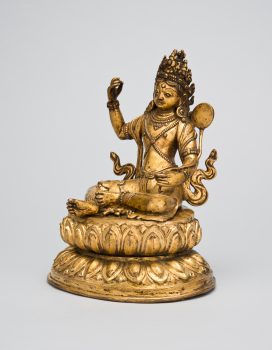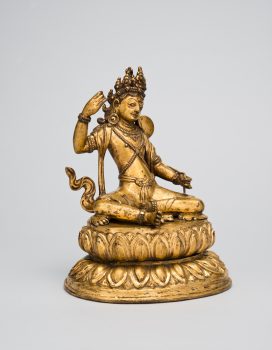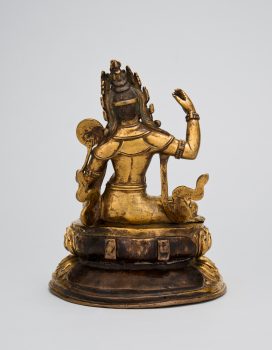Tibet
18th century




Tibet
18th century




This sculpture portrays Padmasambhava, “Precious Teacher” (Tibetan: Guru Rinpoche), in one of his eight manifestations known as Rays of the Sun (Tibetan: Nyima Oser). According to his legendary life story, for five years Padmasambhava practiced in a charnel ground, a gruesome place where dismembered corpses are left to be feasted upon by vultures and wild dogs. With the power of his practice, like the “rays of the sun,” he was able to clear the demonic darkness and terror accumulated in these surroundings. The sculpture shows him as a tantric practitioner, or siddha, seated on an animal hide with the sun—the attribute of Nyima Oser —above his left shoulder at the end of a lasso.
A kind of energy that can be used, individually and collectively, to effect change.
Buddhists believe identity is not fixed but is variable and dependent on causes and conditions. It is a temporary, transitional, and ever-changing interplay of mental and physical elements.
The transmission of teachings from one generation to the next, from teacher to student, traced all the way back to the Buddha without interruption. A complete lineage is essential in Tantric Buddhist practices as it makes the blessings of the teaching more powerful.
Himalayan art includes portraits of legendary and historical humans, including accomplished religious teachers (lamas), the Buddha’s original disciples (arhats), and spiritually accomplished tantric masters (mahasiddhas).
Today, Tibetans primarily inhabit the Tibetan Plateau, situated between the Himalayan mountain range and the Indian subcontinent to the west, Chinese cultural regions to the east, and Mongolian cultural regions to the northeast. During the 7th to 9th century, Tibetan rulers expanded their empire across Central Asia, and established Buddhism as the state religion.
Get the latest news and stories from the Rubin, plus occasional information on how to support our work.